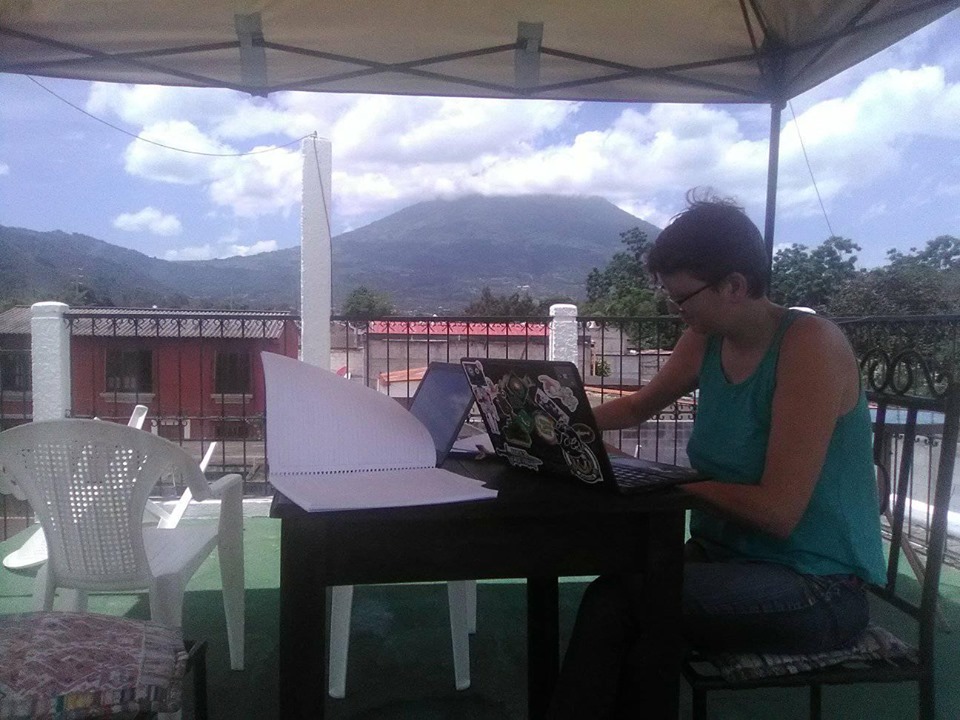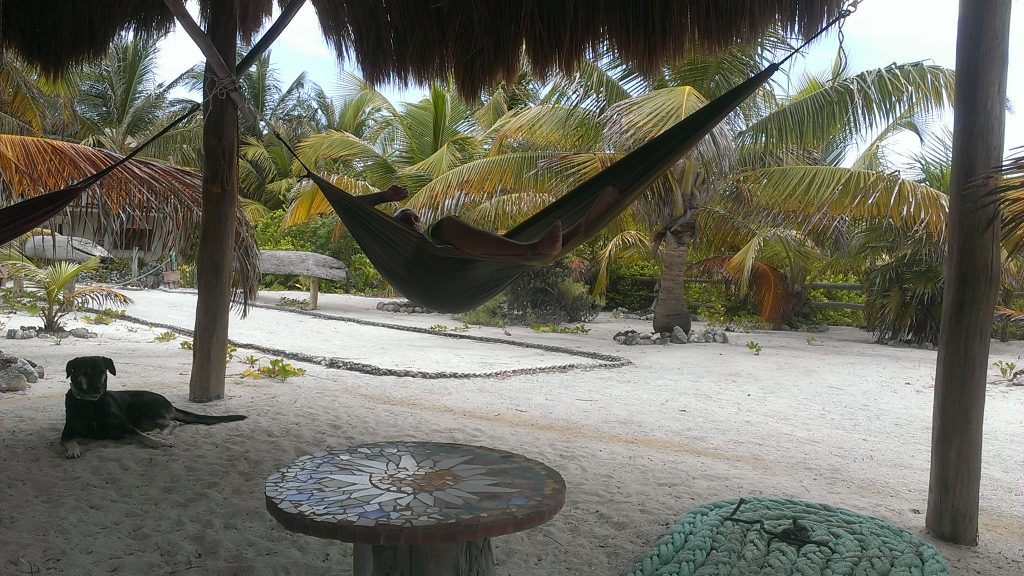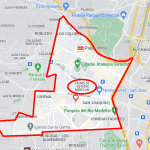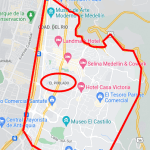How Digital Nomads can Offset a Flight’s Environmental Impact
Table of Contents
As full-time digital nomads, we definitely think about the environmental impact our 3-4 flights a year can have. To lessen this impact, we have made some conscious decisions to offset the CO2 emissions caused by our air travel. The decisions we’ve made, even when combined with our air travel, ensure that we have a lower carbon footprint than we would have living a typical lifestyle back in the States.

Making Infrequent Trips and Staying Longer-Term Reduces the Environmental Impact of Flying
We choose to travel differently than most world-travelers. When we fly to a new country, we’re there for the longer-term; 3-6 months. This means that even though we’re full-time travelers, we may only fly 3-4 one-way trips per year.
For the two of us to fly four times last year between Mexico and Central & South America, our total carbon footprint was 0.47 metric tons. That’s roughly 1\10th of the CO₂ released by someone in the States who commutes to work 5-days a week.

These 3-4 flights a year still have a negative environmental impact. We offset it though once we’re in our new city to ensure that impact is less than a typical couple’s. How do we do this…?
…By Choosing City Living for its Walkability
When choosing the next city we want to live in, we always take its walkability and availability of public transportation into consideration. We would never travel to somewhere where we couldn’t walk to most everything we need, or at the very least have access to public transportation.
In some cities\towns walking everywhere you want to go sometimes isn’t feasible. This is when we turn to transportation that has a lighter environmental impact than just hopping in a car and driving somewhere. In Guatemala, that means shared tuk-tuks. In Negril, Jamaica it’s collective vans that haul 15-20 people across town.
…By not Owning or Renting a Car in our New City
As opposed to a typical American, neither one of us has owned a car for the past ten years. Not owning a car, or even renting one, more than makes up for us flying 3-4 times a year.
According to The United States Department of Transportation Federal Highway Administration, a typical American drives nearly 13,500 miles every year ( based on a 2019 study). This equates to 3.8 metric tons of CO₂ released. That is 8 times the amount of CO₂ that was released for both of us to fly, on the same flights, four times last year.

Living a nomadic lifestyle means never having to own a car. Not only does this lessen our environmental impact, but not owning a car also lessens our financial burdens. As opposed to a typical couple we…
- Have no car payment(s) to make.
- Don’t have to worry about insurance payments.
- Don’t worry about expensive car repairs.
- Have no car upkeep bills (oil changes, new tires, tune-ups, etc.)
- Don’t have to stand in line all day on our birthday to buy new tags.
Not owning, or even renting, a car significantly decreases our impact on the environment. It also allows us to have the money to live as digital nomads.
…By not Commuting to Work Everyday, or at Even All
My worst memory of working a “real job” wasn’t so much the job as it was the commute. Those days are long gone, thankfully. As digital nomads, there is no need for us to work from a specific location. This means; no diving, no public transportation, no carpooling, or any other kind of commute to work.
As long as we have wifi, we can work from anywhere…and we do. If we want to sit on our roof and work, great. If we wanna walk to a cafe, or to a park, and bang out some writing, no problem. What we don’t do though is impact the environment with a daily commute to work.

To Reduce the Negative Environmental Impact of Flying, We Live Off-Grid a Lot of the Year
A lot of our time is spent in Mexico. There are a few reasons for this:
- Cost of Living – The cost of living in Mexico is ridiculously low.
- 180-Day Tourist Visa – This is far more days than most countries allow. Having a 180-day tourist visa means we’re flying less throughout the year.
- We Love It – Mexico is by far our favorite country. Everything about it; the people, the culture, the climate, the food. Nearly everything is perfect for us.
- House Sitting Opportunities – There are so many “snowbirds” living here that finding a house/pet sitting gig is fairly easy.
And house/pet sitting is how we’re able to live off-grid for 5-months a year. Every year we pet sit in a great little house, right on the Caribbean. While we’re there, our environmental impact is nearly zero.

How can our environmental impact be so low? We use nothing but solar power for our electricity. All of the water we use is rainwater that has been collected and saved in a cistren. And nearly all of the food we eat is locally sourced. Best yet, unless you’re shopping for supplies, which we only do once every month or so, there is no need for transportation of any kind.
Living off-grid significantly reduces our average carbon footprint for the year.
Making the Above Lifestyle Choices Offsets the Environmental Impact of Flying
Flying does cause a rather large carbon footprint. We really don’t alter our mode of travel to get from one country to another, though. Instead, we try our best to offset that footprint by making lifestyle choices, outside of flying, which lowers our impact on the environment.
Not only are we making lifestyle choices that make a big impact, as discussed above, but we also make a lot of small choices such as; using refillable water bottles, recycling, shopping only thrift stores, bringing our own containers for carry-out (actually quite popular in Latin America), eating local, etc. All of these choices, big and small, help to lessen our environmental impact.

Paul is a full-time SEO content writer and owner of Word Brokers, LLC. He is also a full-time digital nomad who can be found writing content with his toes in the sand on a beach in Mexico, sipping an espresso in a cafe in Colombia, or chilling by the lake in Guatemala.






2 Replies to “How Digital Nomads can Offset a Flight’s Environmental Impact”
Nice you are thinking about your impact, but ultimately flying leaves a devastating impact.
Your article keeps coming back to the fact your foot print is still far less than an average American. That is a moot point given how the outsized carbon footprint of an average American.
You misunderstand offsetting. The carbon conscious measures you take in locations are great, but do not counter the huge amount of carbon you put in the atmosphere when flying in any way. You are just being environmentally conscious for some parts of the year, while causing huge damage at other times.
If you want to lower your carbon footprint, you could work from home in the US (or Mexico or any other sole country) and stop flying.
I don’t mean to be negative but your article is simply incorrect.
Thank you for the concern, but considering you run a travel blog with dozens of destinations, that I doubt you walked or bicycled to, it’s kind of hard to take your concerns very seriously.